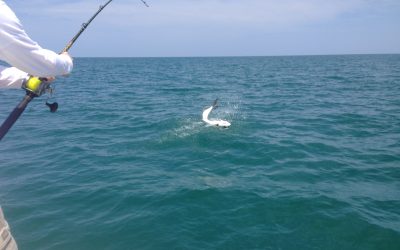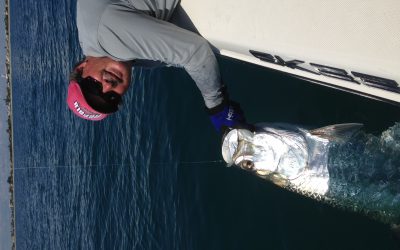Paul MacInnis
A lot of elegant prose has been written trying to describe the epic battles and majestic leaps of the mighty tarpon. I’ll just get right to the point and say they are awesome fish, and you’re in luck because now is a good time to pursue these silver giants along our Brevard County coast. To learn the secrets for targeting this grand fish I talked to local tarpon expert, Captain Jim Ross who’s been catching silver kings for 25 years.
Ross says tarpon patrol our coast from May until October although a warm winter can kick off an earlier run. This year Ross found his first tarpon back in March. Although tarpon fishing can be good any time throughout the summer, Ross says the best month is June when the numbers are good and the fish seem to be more aggressive.
There is no magic spot that always holds tarpon (if there was I certainly wouldn’t tell you about it). Tarpon fishing is a searching game. Ross fishes out of Port Canaveral and Sebastian Inlet. As soon as he clears the inlet he starts running the beach looking for tarpon, focusing his search to the 15 to 40 feet depths. First and foremost he is looking for tarpon themselves, either rolling fish or free jumpers. Lacking that, he’ll look for bait pods. Pogies, mullet and even glass minnows could all hold tarpon, but not every bait pod will have tarpon on it. One of Ross’s time saving secrets is to use the side scan feature on his Lowrance HDS 12 to see if any tarpon sized predators are mingling with the bait.
If it’s early morning or late afternoon Ross and his clients will throw lures for tarpon. For hard baits, Ross likes the Williamson Surface Pro and Popper Pro and the Rapala X-Rap Long Cast Shallow. Ross is also a big fan of the six inch Saltwater Assassin Sea Shad paddle tails. He fishes these on ¾ to 1-1/2 ounce jig heads and says the best colors for tarpon are Opening Night and Silver Phantom/Chartreuse Tail.
If he is not using lures, Ross will be fishing live bait, either pogies or mullet on VMC 7385 circle hooks, size 8/0 or 9/0. Live baits are free lined around concentrations of fish or slow trolled behind the boat.
Ross uses Shimano Saragosa 8000 spinning reels for casting lures and free lining baits, and Okuma SLX lever drag reels for slow trolling. Both reels are teamed up with matching 7’10”, custom 30-50 pound Memory Stix rods that he helps design (http://adventurouscustomrods.com/). At almost eight feet, those rods might seem a little long, but Ross says when the fight nears the boat that extra length helps his anglers keep the line clear of obstacles like the motor.
He spools the reels with 300 yards of 40 or 50 pound test Suffix 832 braid with a 100 yard topshot of 30 or 40 pound test monofilament. He connects the mono to braid using a double Uni-Knot, ten wraps with the braid and five wraps with the mono. The mono top shot provides a lot more stretch than straight braid and that stretch helps cushion the impact on the angler and allows a little extra tolerance for angler errors which reduces the number of pulled hooks and broken lines.
For a leader, Ross attaches five feet of 50 pound test fluorocarbon to the monofilament using a double Uni-Knot with five wraps on each line. He adds another two and a half feet of 80 pound test fluorocarbon that is tied to the 50 pound leader using an Albright Special knot. A lot of anglers would go with a straight seven feet of 80 pound fluorocarbon, but Ross thinks his two stage leader gets more bites because it is more flexible and has less resistance in the water and that allows his lures and baits to have a little more movement.
Ross’s last bit of advice is to determine the speed and direction the tarpon are moving. Set up ahead of the fish and let them approach your baits from behind. You’ll get more bites this way than if you tried to troll or retrieve your baits on an intercept path with a moving school of tarpon.
I can guarantee you hooking up with a big ocean tarpon is an experience you’ll likely never forget. If you want to cut a ton of time off your tarpon learning curve I recommend you hire an expert like Captain Jim Ross who can be reached through his website, http://captainjimross.com/.




